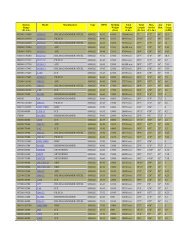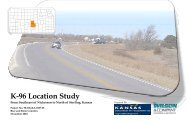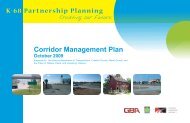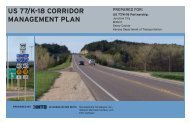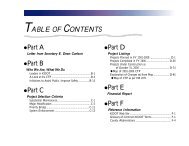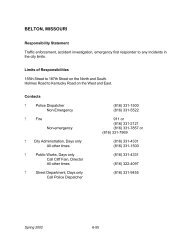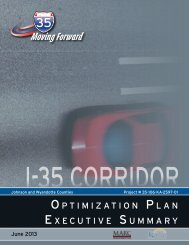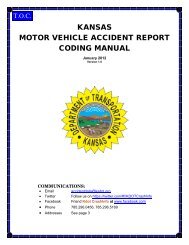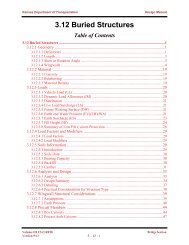Full Plan - Kansas Department of Transportation
Full Plan - Kansas Department of Transportation
Full Plan - Kansas Department of Transportation
Create successful ePaper yourself
Turn your PDF publications into a flip-book with our unique Google optimized e-Paper software.
Section 1: Baseline Condition Report<br />
1.0 Introduction<br />
Background<br />
Intelligent <strong>Transportation</strong> Systems (ITS) are the application <strong>of</strong> information systems<br />
technology and management strategies to increase the safety and efficiency <strong>of</strong> the surface<br />
transportation system. ITS can be applied to both urban and rural environments and to all<br />
modes <strong>of</strong> transportation. The contribution <strong>of</strong> information technology is to provide better<br />
information to assist users and operators <strong>of</strong> the transportation system to make bettercoordinated<br />
decisions. Thus ITS initiatives are not emphasizing the pro<strong>of</strong> <strong>of</strong> new<br />
technologies but rather supporting the transportation objectives <strong>of</strong> increasing safety,<br />
efficiency, and productivity, saving energy and improving environmental quality.<br />
Rural America represents a small and dispersed portion <strong>of</strong> our nation's population, yet it<br />
encompasses a significant portion <strong>of</strong> the transportation system. In <strong>Kansas</strong>, the rural<br />
conditions are even more pronounced. For example, rural areas account for 97 percent <strong>of</strong><br />
the total road mileage, 54 percent <strong>of</strong> the vehicle miles traveled and 78 percent <strong>of</strong> the total<br />
number <strong>of</strong> fatal accidents in <strong>Kansas</strong>. Rural roads have a unique set <strong>of</strong> characteristics<br />
related to travelers, operations and maintenance. Although it is easy to see the benefit <strong>of</strong><br />
ITS in urban areas, rural areas can also benefit from using ITS. Rural ITS encompass<br />
seven critical program areas. These are listed below.<br />
1. Emergency Services:<br />
• Mayday Systems (Automatic Collision Notification),<br />
• Advanced dispatching and vehicle-based response systems, and<br />
• Increased ability <strong>of</strong> emergency services to find rural locations.<br />
2. Tourism/Traveler Information Services:<br />
• Increased stewardship for National and State Parks,<br />
• Traveler information on the Internet (weather and road conditions), and<br />
• Electronic Yellow Pages.<br />
3. Public Mobility Services:<br />
• Advanced transit and paratransit systems using automated vehicle location (AVL)<br />
and improved dispatching,<br />
• Smart card payment/transaction systems for rider payment and tracking, and<br />
• Advanced ride sharing and ride matching systems.<br />
Baseline Condition Report 1-1<br />
Section 1 <strong>of</strong> the <strong>Kansas</strong> Statewide ITS <strong>Plan</strong><br />
July, 00



